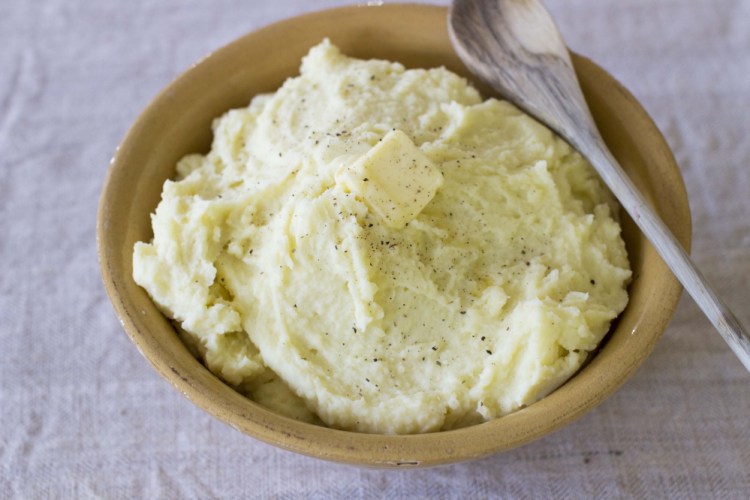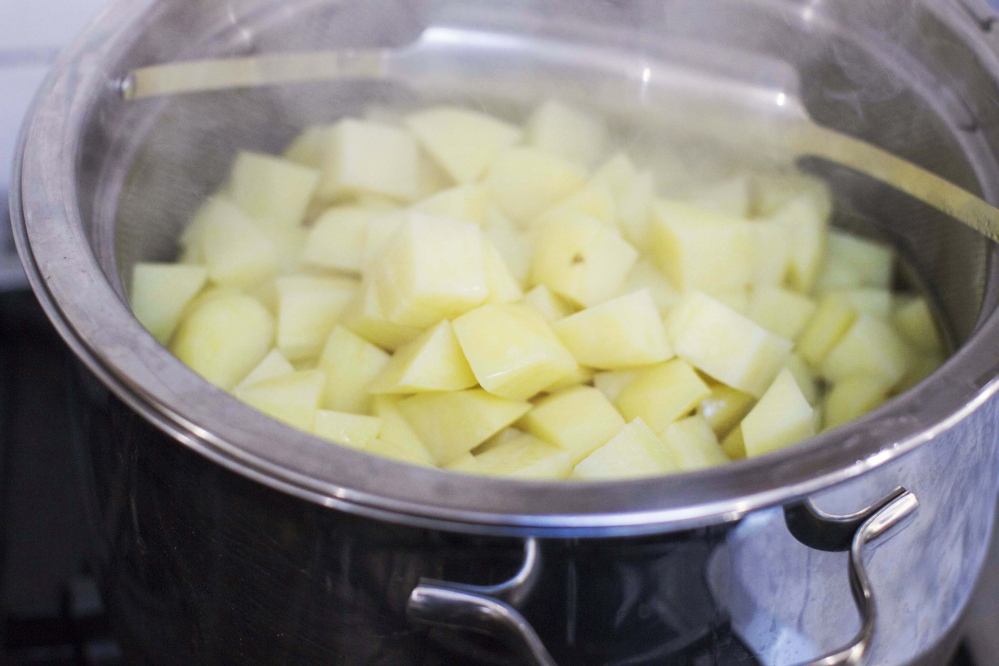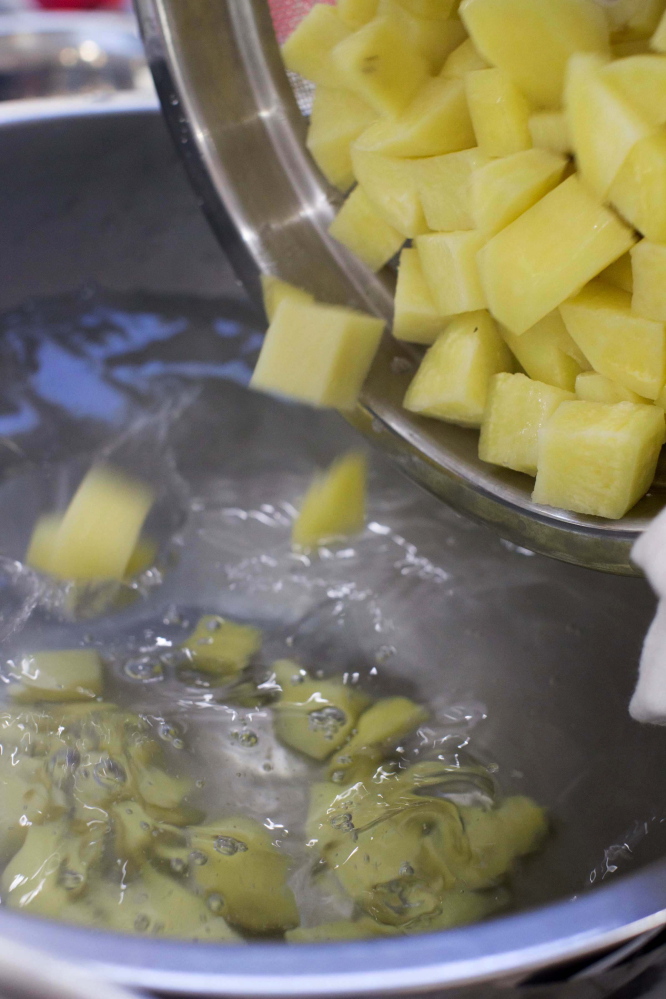I’ve made mountains of mashed potatoes in my little life, faithfully adhering to the method I was taught in cooking school. And I’ve always been reasonably happy with the results. And really, how far wrong can you go with potatoes, butter and cream? Who cares if your mashed potatoes are a little lumpy or gluey?
This year, however, with Thanksgiving looming, I thought I’d do a little homework in an effort to improve on the tried and true. Happily, it was research that paid off.
As ever, the first question is which kind of potato is the best to mash. I experimented with russets (also called baking potatoes, the most famous variety of which is the Idaho), was well as with Yukon golds, which is sort of a cross between a baking potato and a boiling potato. Both worked well, though the Yukon golds are sweeter.
I didn’t test any boiling potatoes. Thin-skinned and firm-fleshed – the red bliss is a prime example – boiling potatoes just don’t mash as well. They also don’t absorb cream and butter as readily as baking potatoes.
The next question is a two-parter: Should the potatoes be cooked in the water or in the oven? And should they be cooked whole in the skin or peeled and cut into chunks?
I started by baking whole potatoes in the skin. Mashed, they were delicious, but texture-wise they weren’t smooth enough. So I tried cooking them in water, and this is where I learned something new. In all of my research, one recommendation kept popping up: Boil the potatoes only halfway, then chill them completely before finishing the cooking process.
Why? Because when you mash a fully-cooked potato, you unleash a ton of gummy starch. But if you cook it only halfway, then cool it, you lock in some of the starch. The finished product is much less gummy when you finish cooking it afterward and then begin mashing.
All of my sources advised peeling the potatoes and cutting them into pieces of equal size so they cook evenly. They also suggested rinsing them off first, to get rid of some the starch. You don’t start them in cold water. The choice is to cook them in water that’s already simmering or in a steamer set over simmering water. I opted for the second choice because it’s easier to cool them off mid-way.
What’s the best tool to mash potatoes? Oddly, it’s not a potato masher, it’s a ricer. Why? Because the quickness with which a ricer forces the cooked potato through its holes keeps the agitation of the starch to a minimum. A good second choice is a food mill. But whatever you do, don’t mash your cooked potatoes in a food processor or blender. They’ll end up gluey enough to paste up wallpaper.
So my method? I steamed the potato chunks for 10 minutes, cooled them completely in ice water, then steamed them again until they were tender. I riced them while still hot (very important), added my softened butter and a heated mixture of cream and milk. Then I gave them a taste. That extra step made a huge difference. They were much creamier than any batch I’d ever made before.
A few notes about the ingredients. It’s fine to use nothing but milk rather than a mix of milk and cream. Likewise, use more or less butter according to your preference. I’ve also included instructions in case you want to make these potatoes ahead of time. Made-ahead mashed potatoes will not be quite as creamy as ones cooked and eaten on the same day, but they’re still quite good and will save you time on Thanksgiving.
CREAMY MASHED POTATOES
For a do-ahead version of this recipe, follow it up to the point of ricing the potatoes. At that point, rice the potatoes into a large microwave-safe bowl. Cover the bowl and chill until you are ready to finish the potatoes. When ready, heat the milk and cream with the salt, and soften the butter. Microwave the riced potatoes, covering the bowl partially with plastic wrap, in 2 minute increments, stirring the potatoes each time, until they are very hot, then add the butter and milk mixture as instructed in the recipe.
Start to finish: 50 minutes (15 minutes active)
Servings: 8
3 pounds russet or Yukon gold potatoes
1/2 cup whole milk
1/2 cup heavy cream
1 teaspoon kosher salt
6 tablespoons unsalted butter, softened
Ground black pepper
Peel the potatoes and cut them into 1-inch chunks. As you peel and cut them, add the potatoes to a large bowl of cold water and swish them around to get rid of excess starch. Transfer the potato chunks to a large steamer insert or a large colander and set over a pot of boiling water. Reduce the heat to medium and steam the potatoes, covered tightly, for 10 minutes.
Lift out the steamer insert. Leave the water boiling (adding more if needed). Return the potatoes to the bowl of cold water. Set the bowl in the sink and run additional cold water over the potatoes for a few minutes. Turn off the water and add several ice cubes. Let the potatoes cool completely in the ice water.
Drain the potatoes, transfer them back to the steamer insert and return to the pot of boiling water. Steam, covered, until tender when pierced with the tip of a paring knife, about another 12 to 15 minutes.
Meanwhile, in a medium saucepan over medium, heat the milk and cream with the salt until hot.
When the potatoes are tender, remove the steamer insert from the pot. Discard any water in the pot. Using a potato ricer and working in batches, rice the potatoes into the pot. Add the butter and stir until melted and incorporated. Add the milk mixture and stir well. Season with salt and pepper, then serve immediately.
Nutrition information per serving: 280 calories; 130 calories from fat (46 percent of total calories); 15 g fat (9 g saturated; 0.5 g trans fats); 45 mg cholesterol; 33 g carbohydrate; 3 g fiber; 3 g sugar; 4 g protein; 260 mg sodium.
Send questions/comments to the editors.





